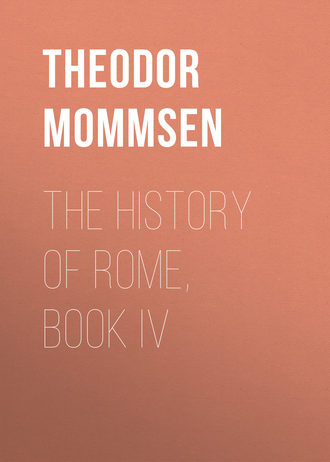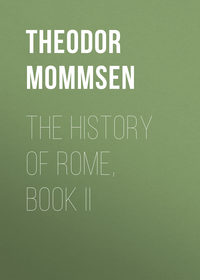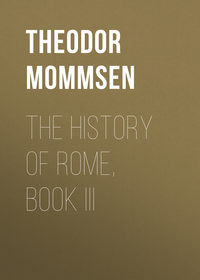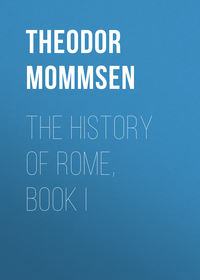 полная версия
полная версияThe History of Rome, Book IV
An explanation quite similar may be given of the "lays of Fescennium," which likewise belong to the burlesque poetry of the Romans and were localized in the South Etruscan village of Fescennium; it is not necessary on that account to class them with Etruscan poetry any more than the Atellanae with Oscan. That Fescennium was in historical times not a town but a village, cannot certainly be directly proved, but is in the highest degree probable from the way in which authors mention the place and from the silence of inscriptions.
363
The close and original connection, which Livy in particular represents as subsisting between the Atellan farce and the -satura- with the drama thence developed, is not at all tenable. The difference between the -histrio- and the Atellan player was just about as great as is at present the difference between a professional actor and a man who goes to a masked ball; between the dramatic piece, which down to Terence's time had no masks, and the Atellan, which was essentially based on the character-mask, there subsisted an original distinction in no way to be effaced. The drama arose out of the flute-piece, which at first without any recitation was confined merely to song and dance, then acquired a text (-satura-), and lastly obtained through Andronicus a libretto borrowed from the Greek stage, in which the old flute-lays occupied nearly the place of the Greek chorus. This course of development nowhere in its earlier stages comes into contact with the farce, which was performed by amateurs.
364
In the time of the empire the Atellana was represented by professional actors (Friedlander in Becker's Handbuch. vi. 549). The time at which these began to engage in it is not reported, but it can hardly have been other than the time at which the Atellan was admitted among the regular stage-plays, i. e. the epoch before Cicero (Cic. ad Fam. ix. 16). This view is not inconsistent with the circumstance that still in Livy's time (vii. 2) the Atellan players retained their honorary rights as contrasted with other actors; for the statement that professional actors began to take part in performing the Atellana for pay does not imply that the Atellana was no longer performed, in the country towns for instance, by unpaid amateurs, and the privilege therefore still remained applicable,
365
It deserves attention that the Greek farce was not only especially at home in Lower Italy, but that several of its pieces (e. g. among those of Sopater, the "Lentile-Porridge," the "Wooers of Bacchis," the "Valet of Mystakos," the "Bookworms," the "Physiologist") strikingly remind us of the Atellanae. This composition of farces must have reached down to the time at which the Greeks in and around Neapolis formed a circle enclosed within the Latin-speaking Campania; for one of these writers of farces, Blaesus of Capreae, bears even a Roman name and wrote a farce "Saturnus."
366
According to Eusebius, Pomponius flourished about 664; Velleius calls him a contemporary of Lucius Crassus (614-663) and Marcus Antonius (611-667). The former statement is probably about a generation too late; the reckoning by -victoriati- (p. 182) which was discontinued about 650 still occurs in his -Pictores-, and about the end of this period we already meet the mimes which displaced the Atellanae from the stage.
367
It was probably merry enough in this form. In the -Phoenissae- of Novius, for instance, there was the line:—
–Sume arma, iam te occidam clava scirpea-, Just as Menander's —Pseudeirakleis— makes his appearance.
368
Hitherto the person providing the play had been obliged to fit up the stage and scenic apparatus out of the round sum assigned to him or at his own expense, and probably much money would not often be expended on these. But in 580 the censors made the erection of the stage for the games of the praetors and aediles a matter of special contract (Liv. xli. 27); the circumstance that the stage- apparatus was now no longer erected merely for a single performance must have led to a perceptible improvement of it.
369
The attention given to the acoustic arrangements of the Greeks may be inferred from Vitruv. v. 5, 8. Ritschl (Parerg. i. 227, xx.) has discussed the question of the seats; but it is probable (according to Plautus, Capt. prol. 11) that those only who were not -capite censi- had a claim to a seat. It is probable, moreover, that the words of Horace that "captive Greece led captive her conqueror" primarily refer to these epoch-making theatrical games of Mummius (Tac. Ann. xiv. 21).
370
The scenery of Pulcher must have been regularly painted, since the birds are said to have attempted to perch on the tiles (Plin. H. N. xxxv. 4, 23; Val. Max. ii. 4, 6). Hitherto the machinery for thunder had consisted in the shaking of nails and stones in a copper kettle; Pulcher first produced a better thunder by rolling stones, which was thenceforth named "Claudian thunder" (Festus, v. Claudiana, p. 57).
371
Among the few minor poems preserved from this epoch there occurs the following epigram on this illustrious actor:—
–Constiteram, exorientem Auroram forte salutans, Cum subito a laeva Roscius exoritur. Pace mihi liceat, coelestes, dicere vestra; Mortalis visust pulchrior esse deo-.
The author of this epigram, Greek in its tone and inspired by Greek enthusiasm for art, was no less a man than the conqueror of the Cimbri, Quintus Lutatius Catulus, consul in 652.
372
IV. XII. Course of Literature and Rhetoric
373
-Quam lepide —legeis— compostae ut tesserulae omnes Arte pavimento atque emblemate vermiculato-.
374
The poet advises him—
–Quo facetior videare et scire plus quant ceteri–to say not -pertaesum- but -pertisum-.
375
IV. III. Its Suspension by Scipio Aemilianus
376
The following longer fragment is a characteristic specimen of the style and metrical treatment, the loose structure of which cannot possibly be reproduced in German hexameters:—
–Virtus, Albine, est pretium persolvere verum Queis in versamur, queis vivimu' rebu' potesse; Virtus est homini scire quo quaeque habeat res; Virtus scire homini rectum, utile, quid sit honestum, Quae bona, quae mala item, quid inutile, turpe, inhonestum; Virtus quaerendae finem rei scire modumque; Virtus divitiis pretium persolvere posse; Virtus id dare quod re ipsa debetur honori, Hostem esse atque inimicum hominum morumque malorum, Contra defensorem hominum morumque bonorum, Hos magni facere, his bene velle, his vivere amicum; Commoda praeterea patriai prima putare, Deinde parentum, tertia iam postremaque nostra-.
377
IV. XIII. Dramatic Arrangements, second note
378
III. X. Measures of Security in Greece
379
IV. I. Greece
380
Such scientific travels were, however, nothing uncommon among the Greeks of this period. Thus in Plautus (Men. 248, comp. 235) one who has navigated the whole Mediterranean asks—
–Quin nos hinc domum Redimus, nisi si historiam scripturi sumus-?
381
III. XIV. National Opposition
382
The only real exception, so far as we know, is the Greek history of Gnaeus Aufidius, who flourished in Cicero's boyhood (Tusc, v. 38, 112), that is, about 660. The Greek memoirs of Publius Rutilius Rufus (consul in 649) are hardly to be regarded as an exception, since their author wrote them in exile at Smyrna.
383
IV. XI. Hellenism and Its Results
384
IV. XII. Education
385
IV. XII. Latin Instruction
386
The assertion, for instance, that the quaestors were nominated in the regal period by the burgesses, not by the king, is as certainly erroneous as it bears on its face the impress of a partisan character.
387
IV. XII. Course of Literature and Rhetoric
388
IV. XII. Course of Literature and Rhetoric
389
IV. XII. Course of Literature and Rhetoric
390
IV. X. Permanent and Special -Quaestiones-
391
Cato's book probably bore the title -De iuris disciplina- (Gell. xiii. 20), that of Brutus the title -De iure civili- (Cic. pro Cluent. 51, 141; De Orat. ii. 55, 223); that they were essentially collections of opinions, is shown by Cicero (De Orat. ii. 33, 142).
392
IV. VI. Collision between the Senate and Equites in the Administration of the Provinces, pp. 84, 205
393
IV. XII. Roman Stoa f.
394
IV. XI. Buildings




